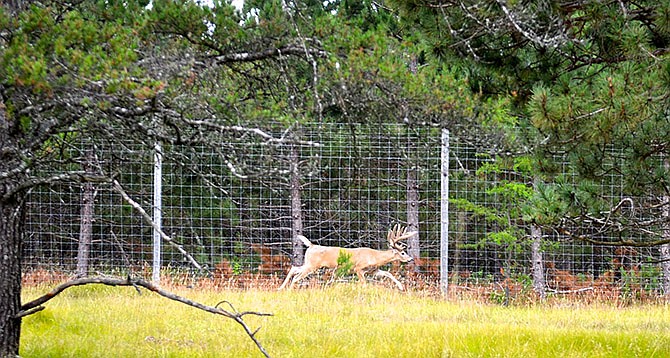Missouri's Conservation Commission has the constitutional authority to regulate captive deer and elk as well as those in the wild, the state Supreme Court ruled Tuesday.
The decision overturned a September 2016 ruling by Osage County Associate Circuit Judge Robert Schollmeyer, acting as a special judge in Gasconade County, who had ruled the commission and Conservation Department had authority only over wild animals, not captive ones.
In a statement, the commission said it was pleased with the ruling: "The Commission will be working closely and in collaboration with hunting preserves and wildlife-breeding facilities to ensure regulation compliance and to minimize the risk associated with the movement and holding of captive deer.
"The goal is to help protect Missouri's deer herd, now and into the future, from the 100 percent fatal chronic wasting disease, which has advanced across the Missouri landscape since it was first found in 2010."
As the commission sought ways to control the spread of chronic wasting disease, or CWD - a fatal neurodegenerative disease - it created a series of regulations aimed at the captive deer and elk industry, to become effective in January 2015.
Deer and elk also are known as cervids.
The commission said it had the regulatory authority under its state constitutional mandate over the "control, management, restoration, conservation and regulation of the bird, fish, game, forestry and all wildlife resources of the state."
Its proposed regulations included banning the importation of cervids from other states or countries, imposing more rigorous fencing requirements and ordering more rigorous record-keeping and veterinary inspection requirements.
The owners of several breeding and private hunting companies sued, arguing the commission's authority didn't extend to their private operations, where the animals have been domesticated and are akin to livestock, not wildlife - and that the regulations violated their "right to farm" under a recent constitutional amendment.
But the unanimous Supreme Court, in a 19-page ruling written by Judge Paul Wilson, said: "In this context, the term 'wildlife' plainly includes all species that are wild by nature (and) the term 'game' plainly includes all species that are wild by nature and that are often pursued for sport, food, or other lawful ends."
The ruling noted the owners had argued that, "when viewed in light of history, grammar, and other contextual clues," the terms "game" and "wildlife" "connote individual animals within a species rather than a wild species as a whole."
But, Wilson wrote, those interpretations "are unreasonable because they would have the Commission's authority be determined not on a rational species-by-species basis but on an unworkable animal-by-animal basis. Finally, and most importantly, (the owners) fail to identify any text in Article IV, Section 40(a), suggesting the broad authority granted to the Commission must be determined one animal at a time."
Additionally, the court found, "Captive or domesticated cervid operations similar to those owned by Respondents existed in this state long before Article IV, Section 40(a), was adopted" in 1936.
"Those operations were regulated under statutes that used terms making cervids 'wildlife' and 'game' even if they were domesticated or raised in captivity."
And Tuesday's ruling pointed to a 1907 state Supreme Court ruling that "that deer 'fawned and raised in captivity' were 'game,' even though the enclosure in which the deer 'were kept was never maintained as a game preserve,' and even though the deer were never 'raised or used for hunting purposes.'"
The high court also ruled the owners "failed to show they are 'engage[d] in farming and ranching practices' and, therefore, cannot invoke this guarantee" under the 2014 "right to farm" amendment.
"It is sufficient to resolve this case to hold only that nothing in the language of article I, section 35 (right to farm), suggests it was intended to limit the Commission's constitutional authority under article IV, section 40(a), to regulate (owner') captive cervids as 'wildlife' and 'game' resources of this state."

